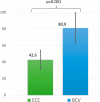Ultrasound-guided supraclavicular cannulation of the brachiocephalic vein may reduce central line-associated bloodstream infection in preterm infants
- PMID: 32382789
- PMCID: PMC7223997
- DOI: 10.1007/s00431-020-03663-y
Ultrasound-guided supraclavicular cannulation of the brachiocephalic vein may reduce central line-associated bloodstream infection in preterm infants
Abstract
The objective of this study was to assess the risk of central line-associated bloodstream infection (CLABSI) of ultrasound (US)-guided cannulation of the brachiocephalic vein (BCV) compared to standard epicutaneous cava catheters (ECCs) in preterm infants. This was a retrospective cohort study in preterm infants with a birth weight of less than 1500 g. Each BCV catheter was matched 1:3 with ECCs according to sex, birth weight, and year of insertion. The main outcome was the CLABSI density rate per 1000 days. Secondary outcomes included CLABSI episodes, CLABSI episodes per infant, and CLABSI/death. A multivariate Cox regression analysis was performed to assess whether the type of catheter (ECC vs. BCV) was associated with CLABSI risk. Ninety-six catheters (21 BCVs and 75 ECCs) in 79 infants were included (993 catheter days). BCV catheters were associated with a reduced CLABSI density rate compared to ECCs (3.05/1000 days vs 21.1/1000 days; p < 0.001). ECCs were associated with increased CLABSI risk compared to BCV catheters in multivariate analysis (hazard ratio 36; (95% CI, 2.5-511); p = 0.008).Conclusion: US-guided supraclavicular cannulation of the BCV was associated with a reduced risk of CLABSI compared to ECCs. This finding deserves further multicenter research. What is Known: • An epicutaneous-cava catheter (ECC) is commonly used in preterm infants for routine care (eg. delivery of nutrition and antibiotics) but this device may not suffice in infants who need high-intensity care (multiple drugs, hemodynamic monitoring, fluid resuscitation etc.). • Ultrasound-guided brachiocephalic vein (BCV) catheterization has shown a high success rate and few immediate complications in neonates and small infants but it has never been compared to standard ECCs. What is New: • When the operator in properly trained, US guided cannulation of the BCV in preterm infants is feasible, safe and may reduce the risk of CLABSI compared to standard ECCs. • This fact may expand the use of BCV catheters in selected high-risk preterm infants who need a large bore venous access.
Keywords: Brachiocephalic vein; Central line–associated bloodstream infection; Epicutaneous cava catheter; Preterm; Ultrasound.
Conflict of interest statement
The authors declare that they have no conflict of interest.
Figures



References
-
- Shalabi M, Adel M, Yoon E, Aziz K, Lee S, Shah PS, et al. Risk of infection using peripherally inserted central and umbilical catheters in preterm neonates. Pediatrics. 2015;136:1073–1079. - PubMed
-
- Pittiruti M. Central venous catheters in neonates: old territory, new frontiers. Invited commentary to peripherally inserted central venous catheters in critically ill premature neonates, by Ozkiraz et al. J Vasc Access. 2013;14:320–324. - PubMed
-
- Pittiruti M. Ultrasound guided central vascular access in neonates, infants and children. Curr Drug Targets. 2012;13:961–969. - PubMed
-
- Lausten-Thomsen U, Merchaoui Z, Dubois C, Eleni Dit Trolli S, Le Saché N, Mokhtari M, et al. Ultrasound-guided subclavian vein cannulation in low birth weight neonates. Pediatr Crit Care Med. 2017;18:172–175. - PubMed
-
- Pirotte T, Veyckemans F. Ultrasound-guided subclavian vein cannulation in infants and children: a novel approach. Br J Anaesth. 2007;98:509–514. - PubMed
Publication types
MeSH terms
LinkOut - more resources
Full Text Sources

